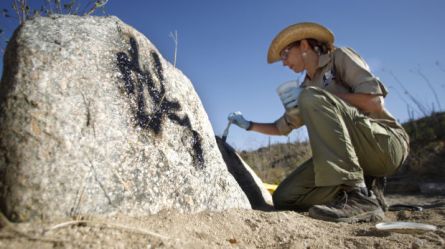 By Beth St. Clair
By Beth St. Clair
State and national parks are sanctuaries, and the Emerald Gem that is the Pacific Northwest has no shortage of outdoor devotees ready to protect its parks’ soul-achingly beautiful mountains, tapestries of forests, and glimmering, shimmering lakes, streams and ocean coasts.
How shocked would nature-lovers be to learn that, over the last several years, graffiti has moved to national parks? The most nefarious instance involved a 21-year-old from New York who painted exhausted-looking persona on logs, in caves, and even the ground, in as many as eight different national park locales. Tagging each oeuvre with “#creepytings,” she deliberately ousted herself by posting pictures on Instagram. A second case involved a European graffiti artist who spray-painted his signature tag on a boulder in Joshua Tree National Park, also posting on Instagram. After public outcry and an initial denial that he had been on park grounds, the artist paid a National Park Service fine to the U.S. District Court.
These audacious examples evoke assumptions that we might have about nature as a source of Commons, natural resources accessible to all members of society that are held in common, not owned privately. We are familiar with graphics or words on man-made structures – even a wooden bench etched with names will not bring out the same level of ire – for we know these things can be built again. But defacing the face of nature? Drawing all over giant Sequoias or rose-colored sandstone cliff walls?
Some have been so bold as to bring up artists’ rights. Perhaps most on point is the Visual Artists Rights Act (17 U.S. Code 106A) (VARA); federal copyright legislation that protects the “moral rights of attribution and integrity” of artists, where moral rights are loosely defined as a non-economic spiritual or personal nature existing independently of an artist’s copyright. Basically, an artist injects her spirit into the work itself. If that artist can successfully argue that she qualifies for VARA’s “recognized stature,” she can prevent the mutilation, misattribution, or destruction of her work.
In the realm of traditional “street art,” advocates have used VARA to argue that a work can simultaneously be vandalism and also be protected by copyright because the expressive and aesthetic value of art is separate from its status in the regulatory process. Thus, the tension implicit in VARA comes from which rights are valued more: property rights or the artist’s. Under the copyright law and property law juxtaposition created by VARA, an owner of a platform on which a picture is painted could have title to a mere copy of the picture on his property, but the artist holds copyright to the expression represented by the image.
However, VARA should not extend to the realm of “nature graffiti” in parks because of the very fact that parks are held in Commons, even if an artist had “recognized stature.” Any balance between property law and artist’s rights is tipped in the favor of the common good, as the benefits of enjoying parks for many should trump the rights of one.
Federal regulation 36 CFR 2.31 that covers “[t]respassing, tampering and vandalism” in park areas under the legislative jurisdiction of the United States could clarify this distinction in the wake of the rising tide of “nature graffiti.” Indeed, though 36 CFR 2.31(3) defines vandalism as “[d]estroying, injuring, defacing, or damaging property or real property,” perhaps the destruction of irreplaceable real property should not be clumped together with the mere damage to property. If the trend of “nature graffiti” continues, Congress should further protect natural wonders by clearly indicating that deliberate destruction or damage to irreplaceable natural monuments or fauna is in a class of its own – with appropriate penalties. In so doing, Congress could reinforce the common property rights that are inherent in national parks lands, as well as protect them for common enjoyment by all.
Image source: tucson.com.